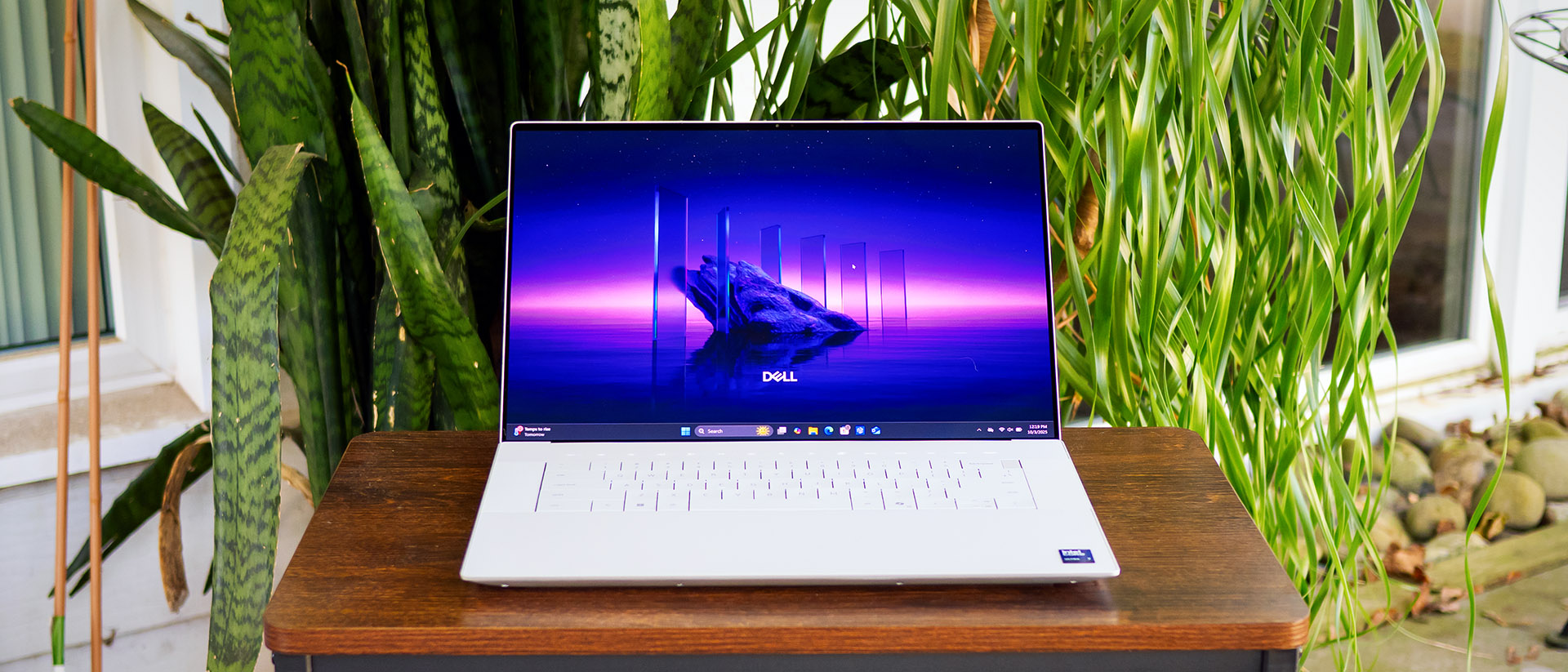Tom's Hardware Verdict
The Dell 16 Premium boasts a futuristic design and vibrant OLED display, backed by solid performance and quiet cooling. Yet for all its polish, the compromised keyboard layout and limited battery life are difficult to overlook.
Pros
- +
OLED touch display
- +
Ultramodern looks
- +
Strong performance
- +
Excellent speakers
- +
Quiet fans
Cons
- -
Very expensive
- -
Short battery life with OLED
- -
Compromised keyboard with touch bar function row
- -
Camera lacks privacy shutter
Why you can trust Tom's Hardware
Dell’s 16 Premium (starting at $1,699) delivers the hallmarks of a high-end laptop: sleek, ultramodern styling, top-tier materials, a gorgeous OLED display option, and performance that rivals desktop replacements. While some design flourishes, like the touch-based function row, undermine usability and the OLED model’s short battery life keeps it from being a truly well-rounded workhorse, this laptop still stands as a Windows-based contender to the Apple MacBook Pro.
Design of the Dell 16 Premium (DA16250)
The Dell 16 Premium inherits its design from the XPS 16 (9640). Although the design has matured a bit, it’s still ultramodern, with radical design cues that position it as a cutting-edge system. Standout features include a seamless glass palm rest, which has no visible touchpad border, and a capacitive touch bar replacing the top keyboard row. (See more about these features will be discussed in the keyboard and touchpad section.) I find the design refreshing, as it looks much more futuristic than the average laptop, though it's divisive among Tom's Hardware's reviewers.

Calling the 16 Premium solid doesn't do it justice. Constructed from aluminum and glass, it delivers impressive strength. OLED-equipped models like our review unit also feature a glass display that compliments the premium feel. Build quality is top-notch, with tight panel gaps and a lid that opens effortlessly with one hand. Our model is white, though Dell also offers a darker graphite finish.
Measuring 14.1 x 9.4 x 0.75 inches (WDH), the 16 Premium shares a nearly identical footprint with the Apple MacBook Pro 16-Inch (14.01 x 9.77 x 0.66 inches), and weighs nearly the same, at 4.65 pounds to the Apple’s 4.67 pounds.
Dell’s port selection is minimal, featuring three Thunderbolt 4 ports (two on the left, one on the right), a microSD card slot, and an audio jack. Although USB Type-C has become mainstream, traditional USB-A remains a need for many users, so investing in adapters may be necessary. For wireless connectivity, the 16 Premium boasts an Intel networking card supporting Wi-Fi 7 and Bluetooth 5.4.
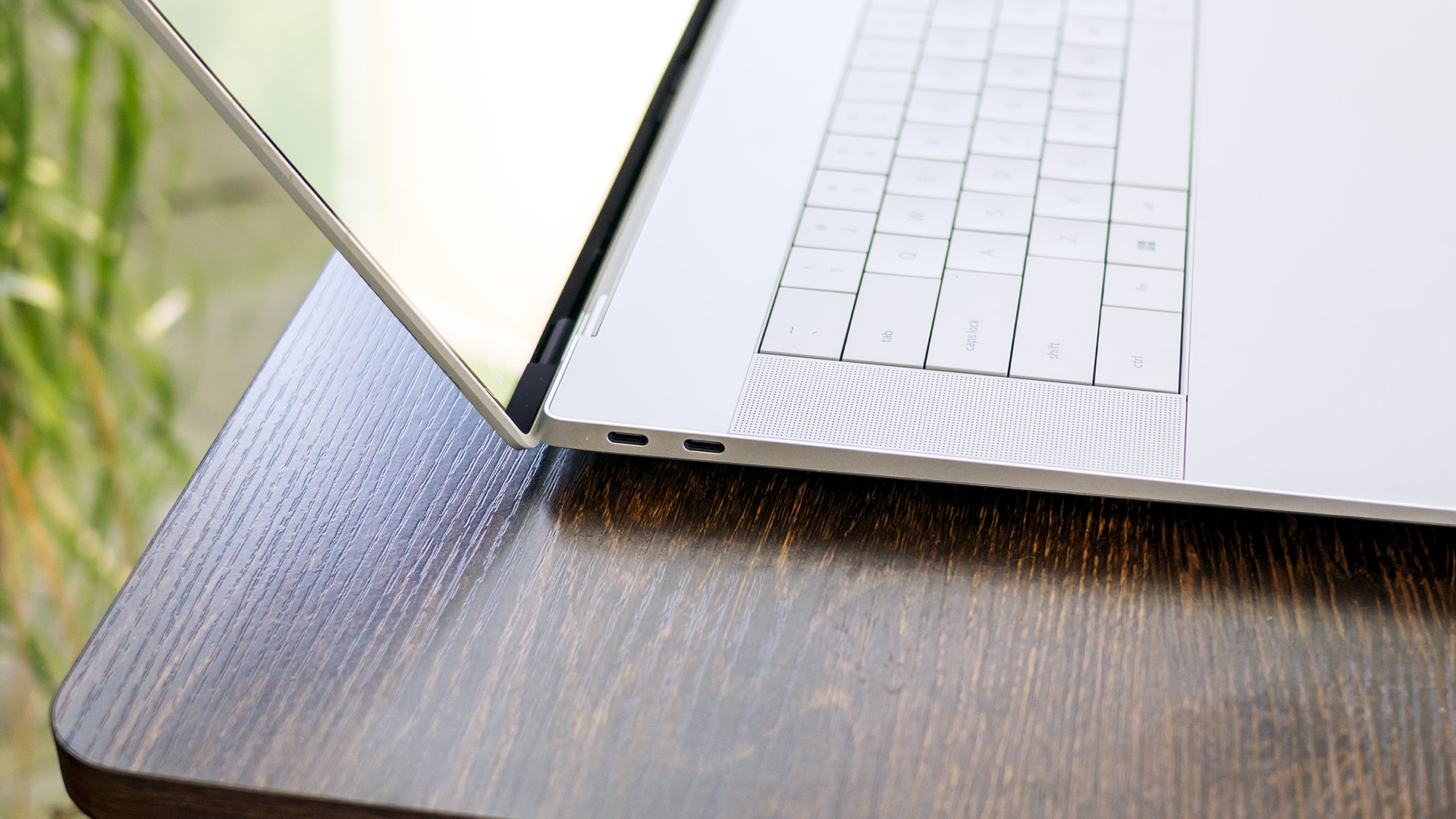
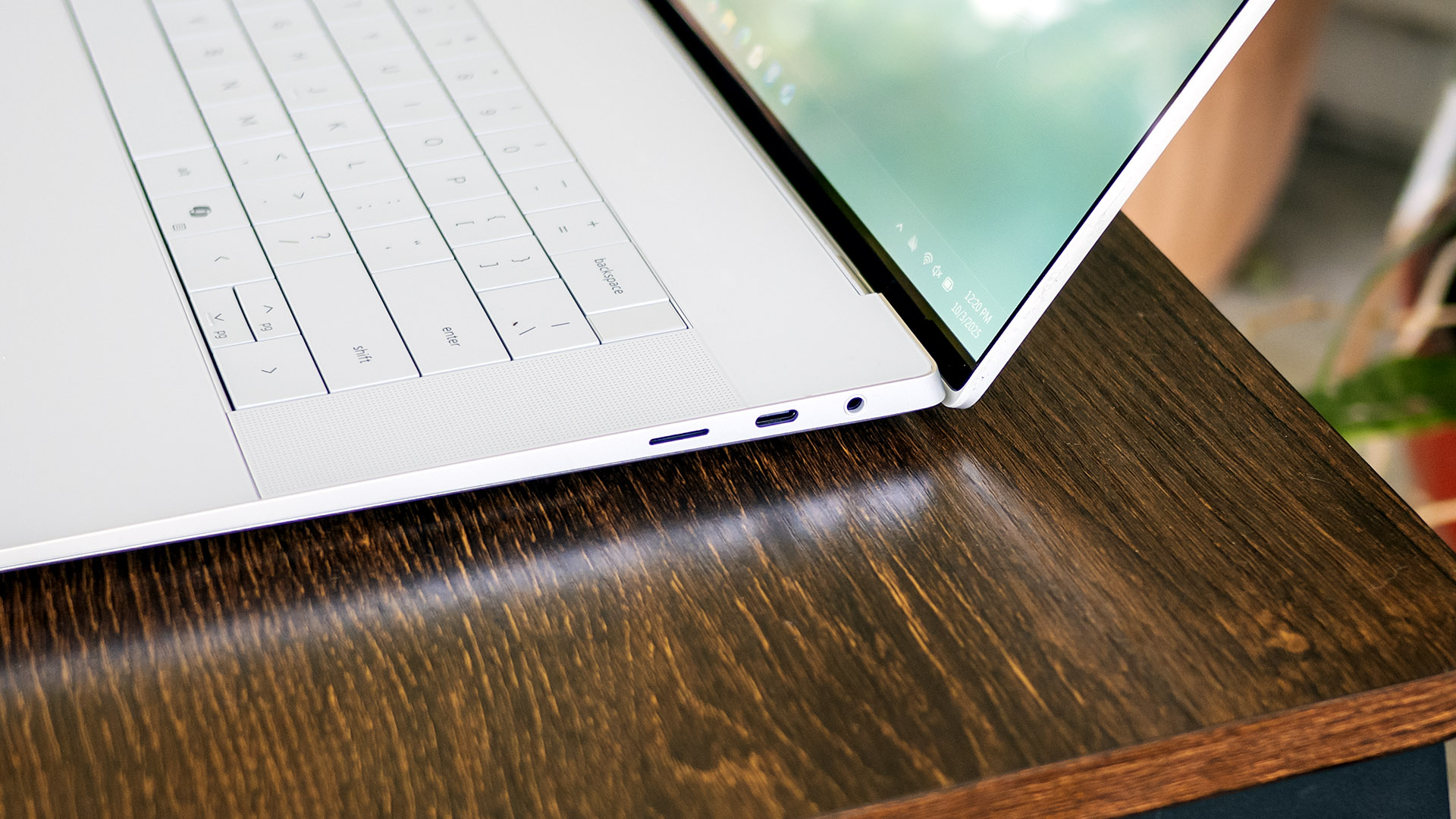
Dell 16 Premium (DA16250) Specifications
CPU | Intel Core Ultra 7 255H |
Graphics | Nvidia GeForce RTX 5070 (8GB GDDR7, 65W TGP, 1,425 MHz boost clock) |
Memory | 32GB LPDDR5X-8400 |
Storage | 1TB SSD (KIOXIA BG6) |
Display | 16.3-inch, OLED, 16:10, 3840 x 2400, 120 Hz, touch |
Networking | Intel Wi-Fi 7 BE201, Bluetooth 5.4 |
Ports | 3x Thunderbolt 4, 3.5 mm audio jack, microSD card reader |
Camera | 1080p IR |
Battery | 99 WHr |
Power Adapter | 130 W Type-C |
Operating System | Windows 11 Home |
Dimensions (WxDxH) | 14.1 x 9.4 x 0.75 inches |
Weight | 4.65 pounds |
Price (as configured) | $2,799.99 |
Productivity Performance on the Dell 16 Premium
Our Dell 16 Premium review unit is a high-end configuration, equipped with Intel’s Core Ultra 7 255H processor, an Nvidia GeForce RTX 5070 GPU, 32GB of RAM, and a 1TB SSD.
The GeForce RTX 5070 is a notable bonus for content creators and media generation. While it's capable of gaming, this laptop is not likely to perform better than an entry-level gaming model, as the GPU has a mere 65 W total graphics power.
Get Tom's Hardware's best news and in-depth reviews, straight to your inbox.
In our benchmark comparisons, its primary rival is the Apple MacBook Pro 16-inch, tested in a $3,649 setup with a 14-core M4 Pro CPU, 20-core GPU, and 48GB of RAM. On the Windows side, we included the HP OmniBook Ultra, which was $1,749 as tested featuring an AMD Ryzen AI 9 HX 375 CPU and AMD Radeon 890M integrated graphics. Completing the lineup is Dell’s previous-generation XPS 16 (9640) using older components: a Core Ultra 7 155H and an RTX 4070 GPU.
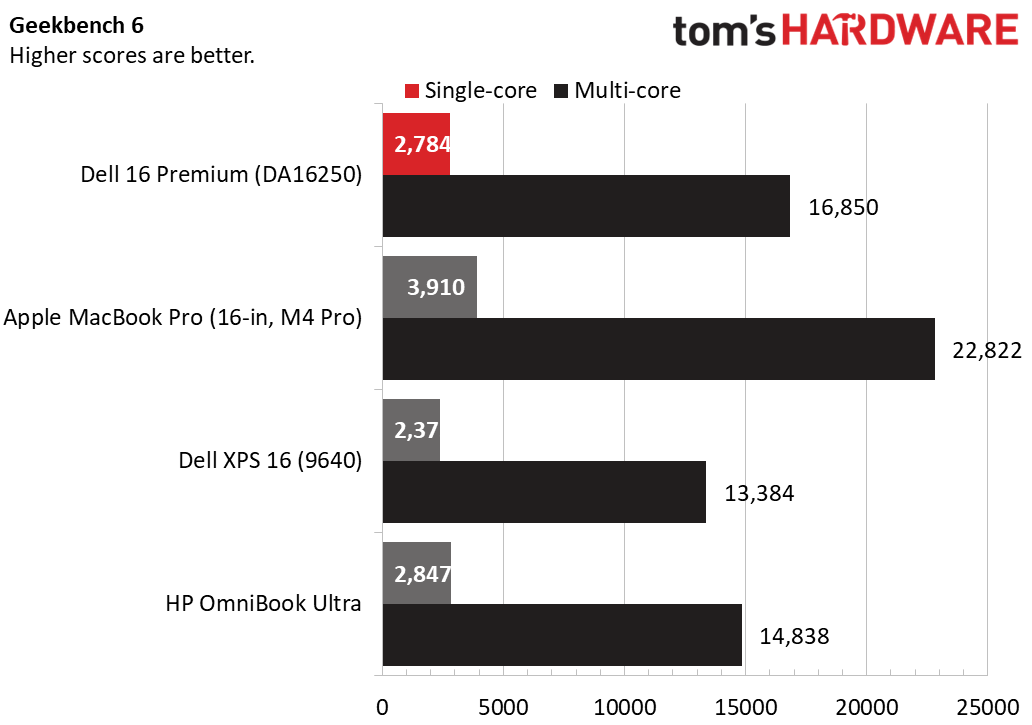
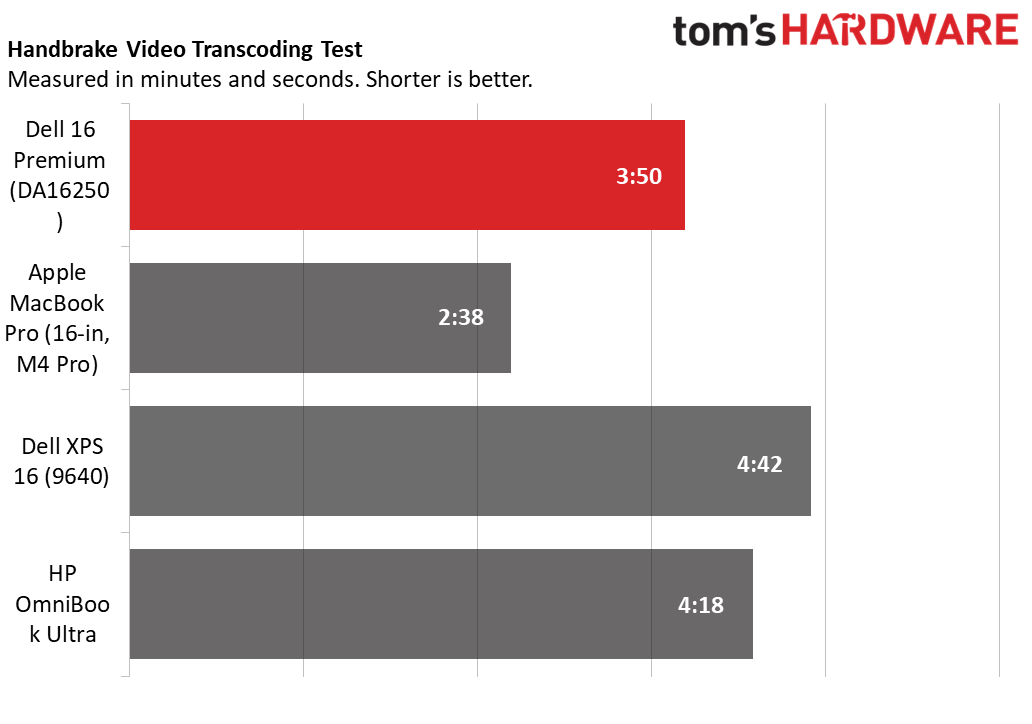
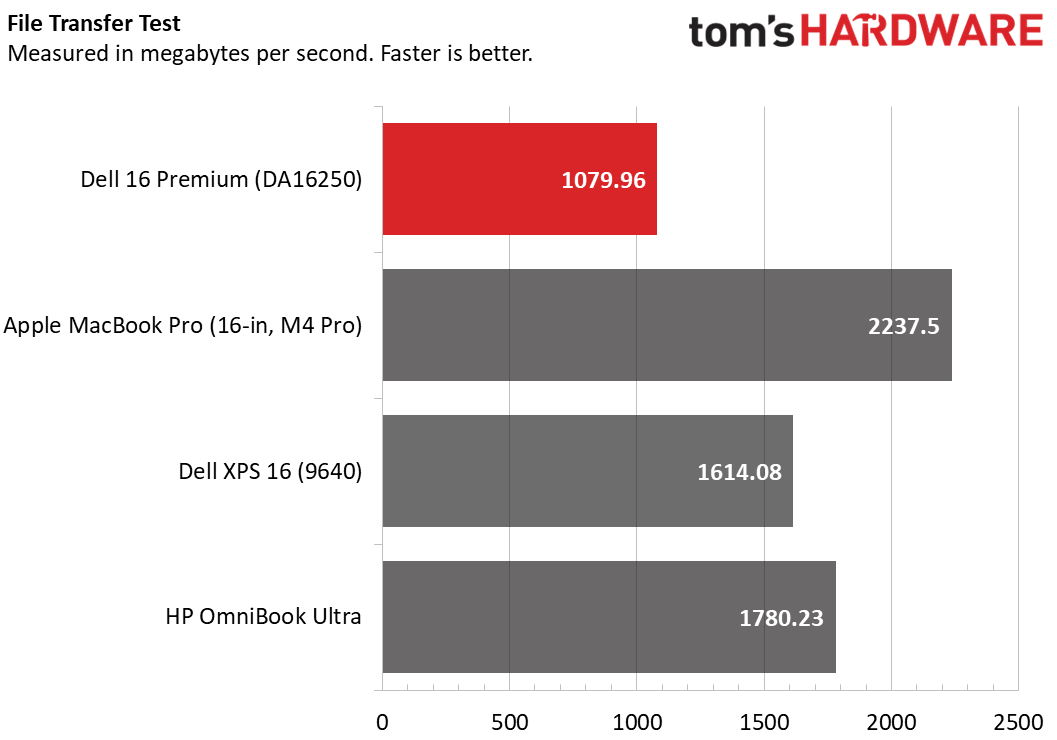
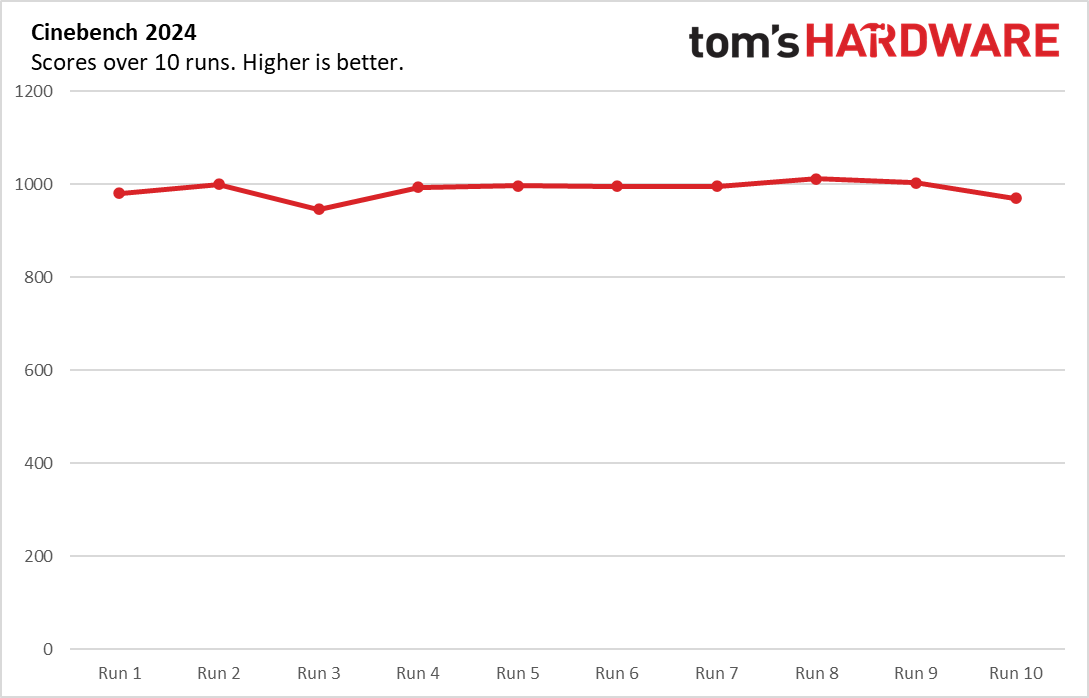
In Geekbench 6’s synthetic CPU test, the Dell 16 Premium posted a single-core score of 2,784, the second lowest in our group that was only ahead of the XPS 16 (2,373) and trailed the AMD-powered HP OmniBook Ultra (2,847). Its multi-core performance was better, reaching 16,850 points and surpassing the HP’s 14,838. The Apple MacBook Pro 16-inch was in a league of its own, with the M4 Pro producing a score of 3,910 in single-core and a commanding 22,822 in multi-core.
The Dell 16 Premium underperformed in our 25GB file transfer test, averaging just 1,079.96 MBps. In contrast, the HP OmniBook Ultra reached 1,780.23 MBps, while the MacBook Pro 16-inch remained out of reach, delivering 2,237.5 MBps, more than twice the Dell’s throughput.
In our Handbrake test, the Dell 16 Premium completed the 4K-to-1080p transcode in 3 minutes and 50 seconds, decisively ahead of the XPS 16 (4:42) and HP OmniBook Ultra (4:18). Still, it couldn’t touch the MacBook Pro 16-inch, which finished in 2 minutes and 38 seconds.
We stress-tested the 16 Premium with 10 consecutive runs of Cinebench 2024. During the test, scores ranged between 980.7 and 1,011.75 points, indicating stable thermal performance.
Display on the Dell 16 Premium
The base configuration of the 16 Premium features a 16.3-inch non-touch IPS panel with a 1920 x 1200 resolution. Our review unit upgrades to an OLED display, offering a sharper 3840 x 2400 resolution, touch functionality, and a dynamic refresh rate ranging from 48 to 120 Hz.
The picture quality is nothing short of captivating. While watching Planet Earth III, I could discern subtle details in shadowed night scenes and was struck by the HDR brilliance of sunlight piercing through jungle foliage. The 120 Hz refresh rate lends a silky smoothness to everyday interactions, whether dragging windows or scrolling content. Touch responsiveness is excellent, and the hinge provides enough resistance to minimize wobble during use. The only drawback is the glossy glass surface, which tends to attract fingerprints and dust.
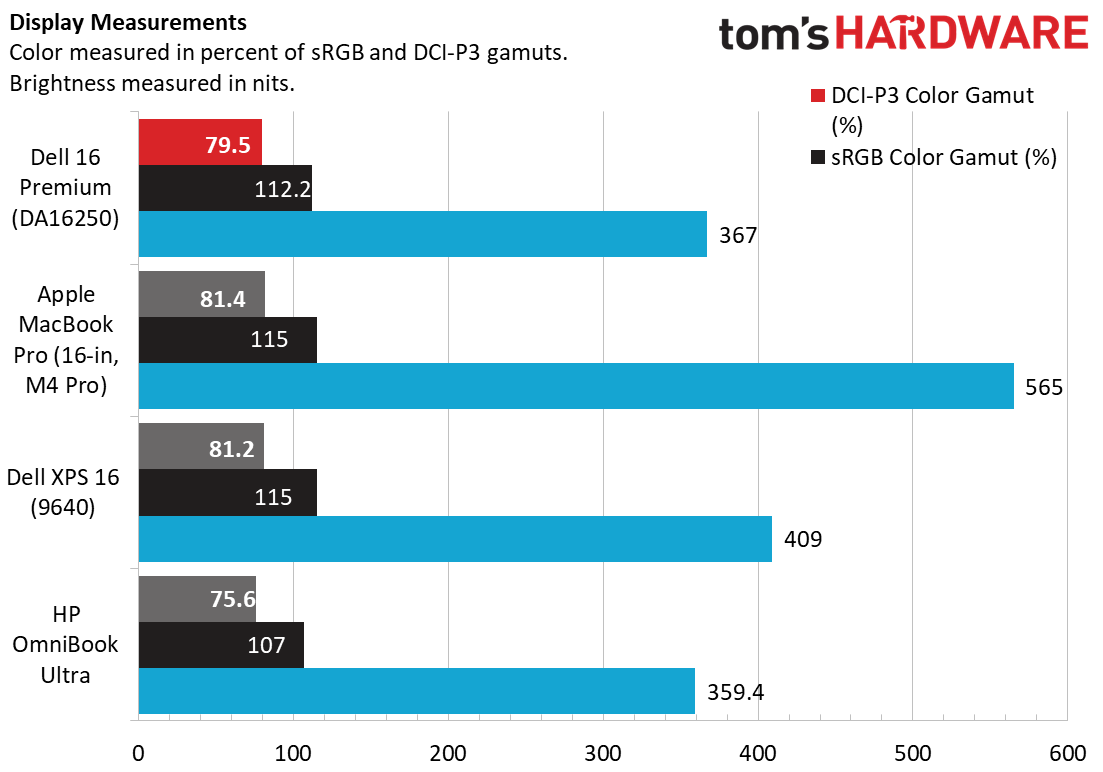
These laptops deliver strong color coverage, with the Dell 16 Premium reaching 79.5% of the DCI-P3 gamut and 112.2% of sRGB, putting it within a couple percentage points of its peers. Its peak brightness of 367 nits may seem modest, but that’s typical for OLED panels; by contrast, the MacBook Pro relies on mini-LED technology. In HDR testing, portions of the Dell’s display peaked at 572 nits.
Keyboard and Touchpad on the Dell 16 Premium
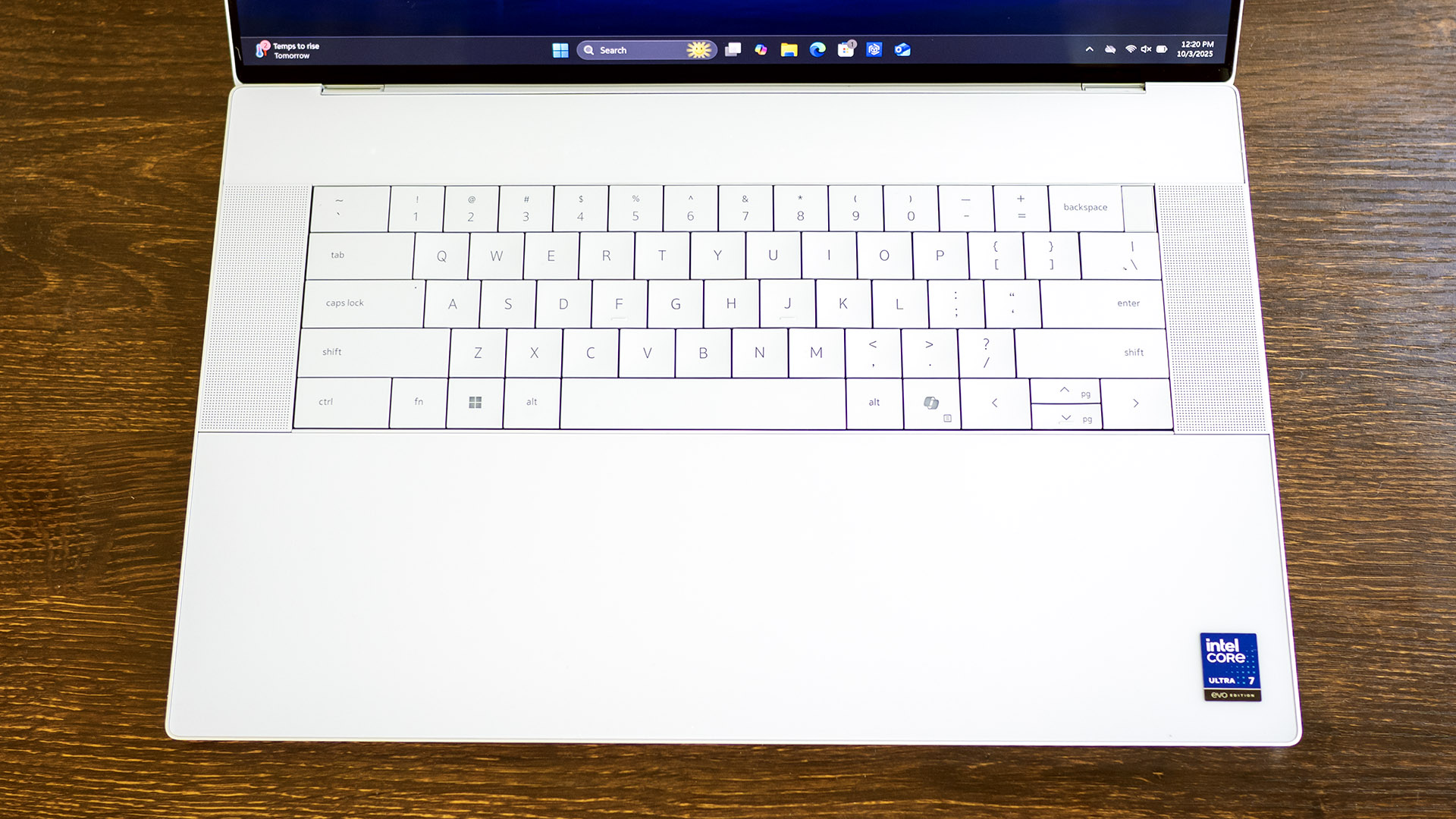
Dell made some radical design choices with the 16 Premium around input devices. The most divisive is the replacement of the traditional top-row function keys with a capacitive touch bar. Each “key” responds instantly to touch, though it lacks haptic feedback. By default, the bar displays media and system controls, such as volume, brightness, and the like, and supports Fn-Lock via the Fn + Esc shortcut to make F1 through F12 primary. As someone that relies on keyboard shortcuts whenever possible, such as Alt + F4 to close a window, I found this design counterintuitive, as it required me to look down each time I wanted to hit an F key.
Dell’s zero-lattice keyboard design eliminates spacing between keys, which is an aesthetic rather than a functional choice. The keys deliver decent tactile feedback, with an adequate 1 mm of key travel and a gentle cushion at the bottom of each stroke. I clocked 114 words per minute with 99% accuracy on MonkeyType, which is about as quickly as I can go on a laptop. That said, the arrow key cluster’s half-height up and down keys and full-size left and right keys aren’t intuitive. The power button, located adjacent to the backspace key, doubles as a fingerprint reader for biometric login.
The white keyboard paired with white backlighting is a risky design choice. Under bright lighting, the illuminated typeface can become difficult to make out. Having encountered this issue on previous white XPS models, I was curious to see whether Dell had addressed it. Thankfully, they have. The ambient light sensor now intelligently disables the backlighting in well-lit environments, retaining legibility. Conversely, in low-light settings, the backlighting activates appropriately, ensuring the typeface remains clearly visible.
As for the touchpad, it’s centered below the keyboard as expected, even though it has no visible border. Initially, I had reservations, but the absence of defined edges didn’t hinder usability. The haptic motors deliver a satisfying tactile bump with each press, and right-clicking proved consistently accurate.
Audio on the Dell 16 Premium
For a fairly slim laptop, the 16 Premium delivers first-rate audio. Its quad-speaker setup, consisting of two 3 W woofers and two 2 W tweeters, produces rich, full-bodied sound that matches entry-level Bluetooth speakers. Dubstep tracks from Seven Lions came through with crisp vocals and punchy bass drops, while Steve Winwood’s Valerie showcased the system’s clean instrument separation.
The one wrinkle in this setup: Dolby Atmos equalizers aren’t enabled out of the box. I had to manually download the Dolby Access app from the Windows Store, which felt like an oversight. While the preset modes didn’t dramatically alter the sound (I stuck with Balanced), they did further improve the already excellent clarity.
Upgradeability of the Dell 16 Premium
Accessing the 16 Premium’s internals is straightforward: the bottom panel is secured by eight Torx screws, all conveniently uniform in length. After removing them, the perimeter clips need to be gently disengaged. I used a plastic trim tool for this step, carefully working my way around the edges.
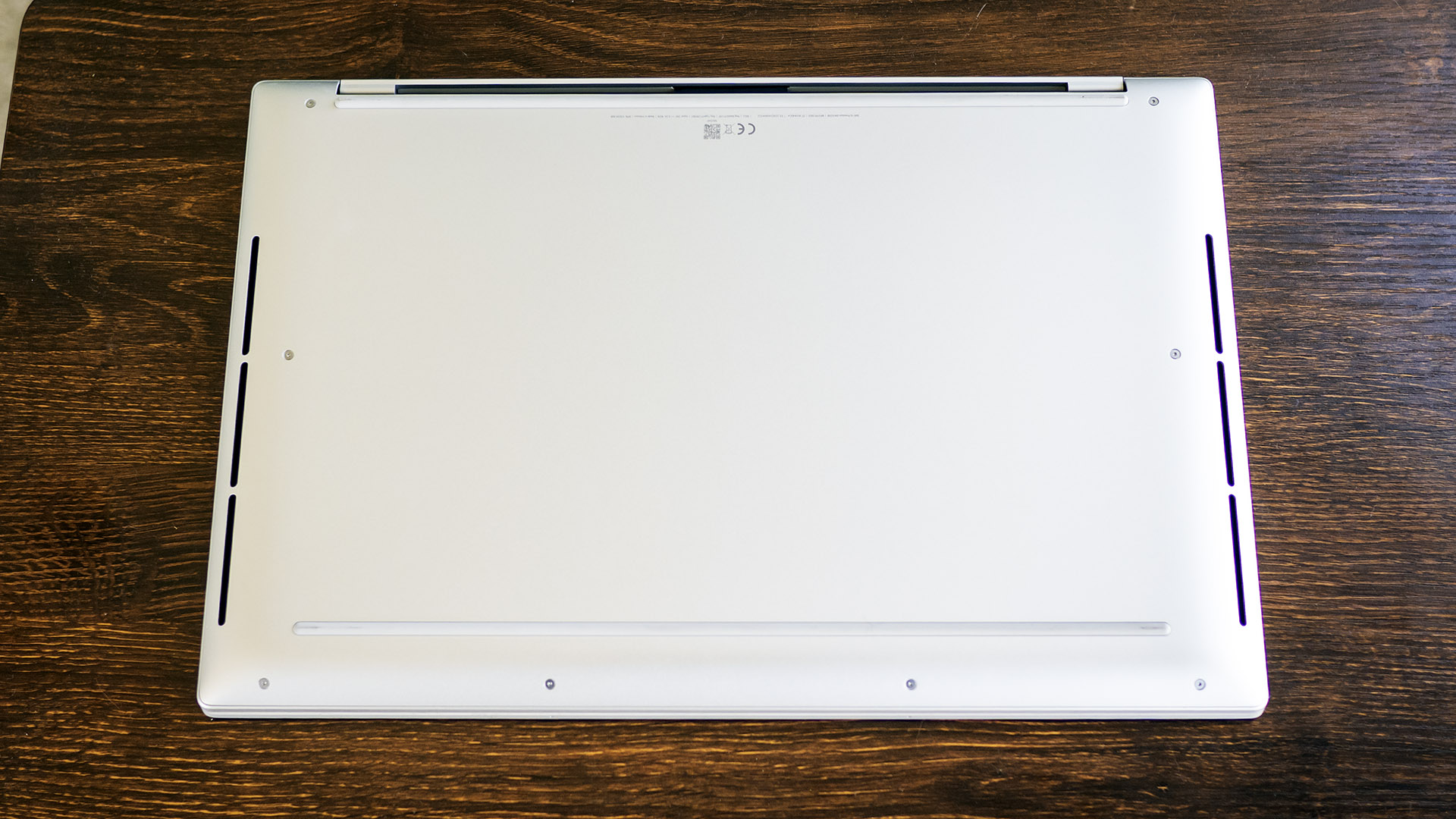
Options for upgrades and repairs are minimal. Only the M.2 storage drive and battery can be replaced; all other components are soldered and non-serviceable.
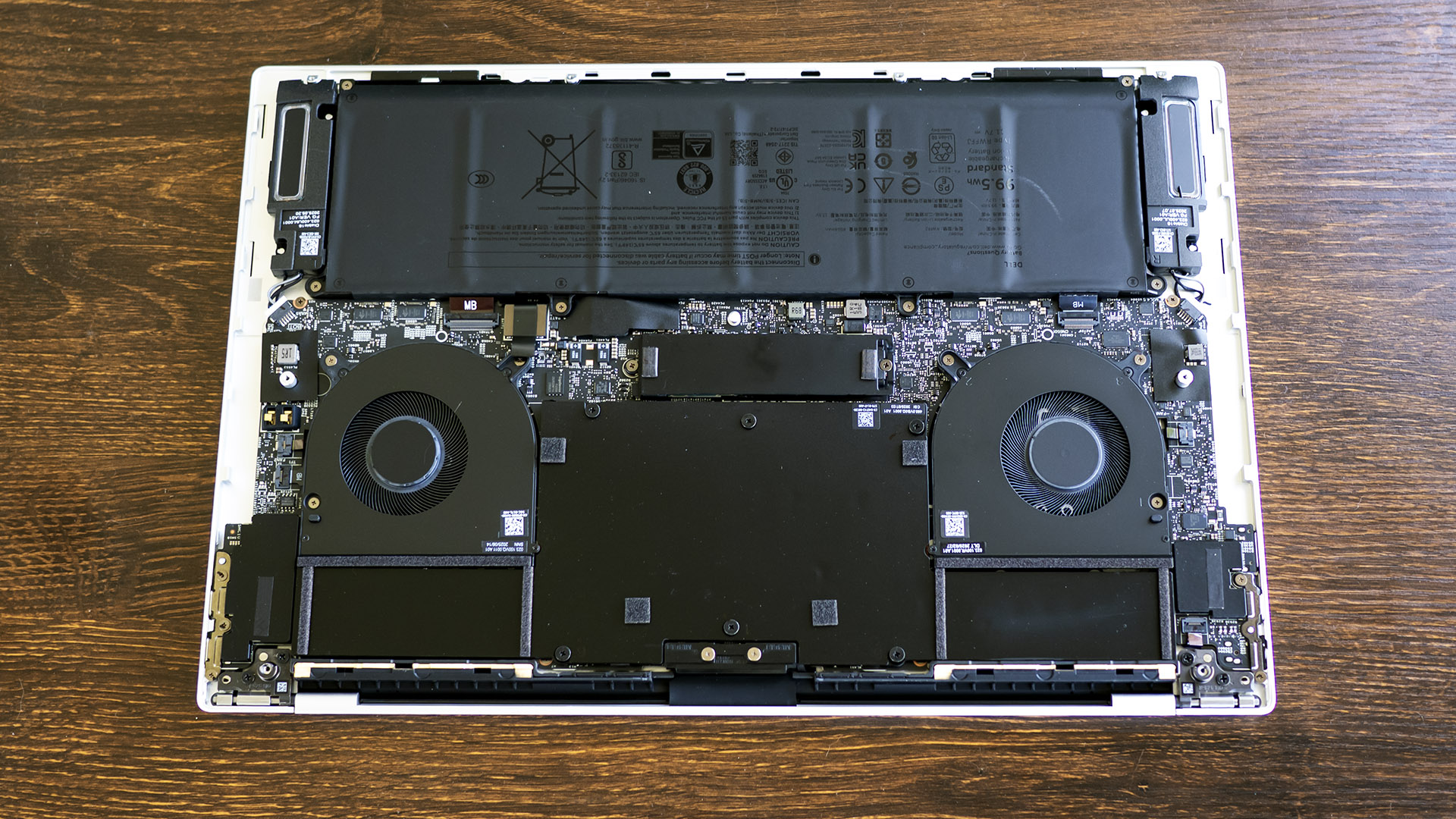
Battery Life on the Dell 16 Premium
In our battery test, which includes web browsing, video streaming over Wi-Fi, and OpenGL workloads at 150 nits, the Dell 16 Premium lasted just 7 hours and 15 minutes. That’s over three hours less than the previous-generation XPS 16 (10:44) and more than five hours behind the HP OmniBook Ultra (12:52). The MacBook Pro 16-inch remained a superstar, clocking an exceptional 21 hours and 1 minute. Clearly, Dell has room to improve its power efficiency.
Some clue as to what’s going on reside in Dell’s own battery estimates. In their internal testing, OLED-equipped models are rated for just 9 hours of Netflix streaming, compared to 27 hours on the non-OLED variant, a threefold difference. While we couldn’t verify those figures, the takeaway is clear: users prioritizing battery life should avoid the OLED panel.
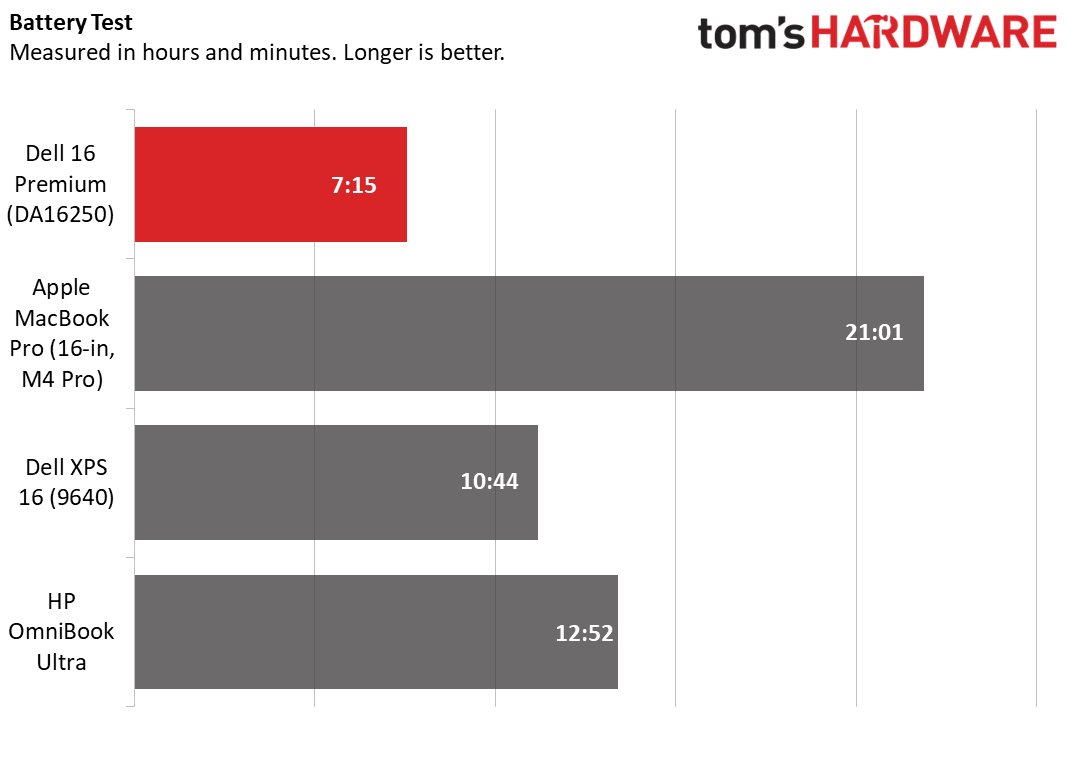
Heat on the Dell 16 Premium
Thermal management on the 16 Premium is handled by two internal fans, which vent heat through rear exhausts lining the display hinge. The system performs well: during our Cinebench stress loop, surface temperatures peaked at just 78 degrees F on the touchpad, 86 F between the G and H keys, and 93 F on the underside near the exhaust vents. Internally, the Core Ultra 7 255H processor operated at an average temperature of 78 C.
Throughout testing, the chassis remained comfortable to the touch, and the fans operated quietly, blending into ambient household noise.
Webcam on the Dell 16 Premium
Dell’s webcam offers impressive picture quality. Despite only having a 1920 x 1080 video resolution, the picture is sharp, clear, and almost free of noise even in slightly darker than optimal environments. It also offers an IR sensor for facial recognition, allowing password-less logins using Windows Hello. Alas, Dell missed adding a sliding privacy shutter or an e-shutter, which competitors like HP and Lenovo often offer.
Software and Warranty on the Dell 16 Premium
Dell preinstalls a few utilities on the 16 Premium, including the My Dell app, which shows system health, warranty info, and access to some settings like Dolby Vision display modes. Users probably won’t need to interact with this app regularly.
The system also comes with one year of Dell Care Plus, which provides onsite repairs following remote diagnostics. It also includes proactive hardware monitoring via the Support Assist app, which can anticipate component failures and, according to Dell, even initiate automatic part replacements.
Dell also includes a years’ subscription of McAfee Premium anti-virus, not a trial.
A one-year warranty is standard, with extended coverage available. Accidental damage coverage is also available via Dell Premium for $89.
Dell 16 Premium (DA16250) Configurations
Dell’s 16 Premium begins at $1,799, equipped with a Core Ultra 7 255H processor, Arc 140T integrated graphics, 16GB of RAM, and a 512GB SSD. The base configuration features a 1920 x 1200 non-touch display with a variable refresh rate of 30–120 Hz and a peak brightness of 500 nits. Our $2,949 review unit steps up to a 4K OLED touchscreen, discrete Nvidia RTX 5070 graphics, and doubled memory and storage (32GB of RAM and a 1TB SSD).
Customizable models offer a Core Ultra 9 285H CPU, up to 64GB of RAM, and storage options reaching 4TB. Graphics upgrades include in-between options of the RTX 5050 and 5060. The laptop is available in Graphite and Platinum finishes.
Our review unit is priced in line with the Apple MacBook Pro 16-inch featuring the 14-core M4 Pro, which is $2,499 with 24GB of RAM or $2,899 with 48GB. Opting for 1TB of storage pushes the price to $3,499. On the Windows side, Dell faces limited competition. One notable contender we haven’t yet tested is the Lenovo Yoga Pro 9i Aura Edition, listed at $1,899 at the time of writing. It features a Core Ultra 9 285H processor, RTX 5060 GPU, 32GB of RAM, 1TB SSD, and a 3000 × 2000 OLED display.
Bottom Line
Dell’s 16 Premium largely delivers on its high-end ambitions. Its forward-looking design impresses with both quality and style, and it offers excellent entertainment potential with its beautiful OLED screen and quad speakers. Performance is also strong, at least among Windows machines, thanks to an Intel Core H-class CPU and quiet, effective cooling.
However, some design choices detract from usability. The capacitive touch bar, while responsive, lacks the tactile intuitiveness of physical keys, and the absence of USB-A ports limits connectivity. Our most notable complaint is the disappointing battery life of the OLED model.
Despite the Premium rebrand, this laptop still has all of the promise and compromises of the XPS 16. If you want a futuristic rival to the MacBook Pro, it's an option, but you'll have to handle the trade-offs to get the cool design and performance.

Charles Jefferies is a freelance reviewer for Tom’s Hardware US. He covers laptop and desktop PCs, especially gaming models.
